The Watt Meter Market is estimated to be valued at USD 22.3 billion in 2025 and is projected to reach USD 41.1 billion by 2035, registering a compound annual growth rate (CAGR) of 6.3% over the forecast period.
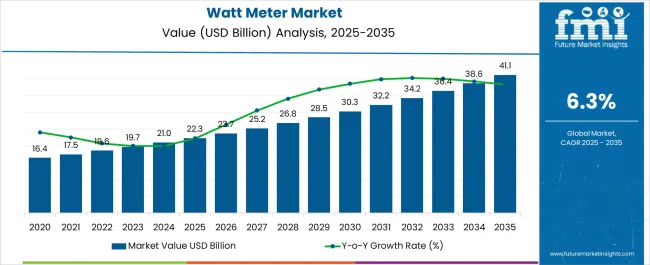
| Metric | Value |
|---|---|
| Watt Meter Market Estimated Value in (2025 E) | USD 22.3 billion |
| Watt Meter Market Forecast Value in (2035 F) | USD 41.1 billion |
| Forecast CAGR (2025 to 2035) | 6.3% |
The Watt Meter market is witnessing robust growth as the demand for precision power measurement and monitoring systems continues to increase across industrial, commercial, and residential sectors. The current market scenario reflects a shift toward digitalized and automated energy management solutions that enhance accuracy, reduce operational inefficiencies, and support sustainability initiatives.
The adoption of watt meters has been accelerated by the expansion of industrial automation, grid modernization, and the need for effective energy consumption tracking in an era of rising electricity costs. Future outlook is being shaped by the transition toward smart grids, renewable energy integration, and the growing implementation of IoT and AI-enabled monitoring devices.
The market is also benefiting from regulatory focus on energy efficiency and compliance, which is driving large-scale deployment across both developed and developing economies As energy infrastructure evolves, watt meters are expected to play a central role in enabling efficient energy usage, predictive maintenance, and improved load management, ensuring continued market growth.
The watt meter market is segmented by type, end use, power type, phase, and geographic regions. By type, watt meter market is divided into Digital Watt Meter and Analog Watt Meter. In terms of end use, watt meter market is classified into Industrial, Residential, and Commercial & Institutional. Based on power type, watt meter market is segmented into AC Power and DC Power. By phase, watt meter market is segmented into Three Phase and Single Phase. Regionally, the watt meter industry is classified into North America, Latin America, Western Europe, Eastern Europe, Balkan & Baltic Countries, Russia & Belarus, Central Asia, East Asia, South Asia & Pacific, and the Middle East & Africa.
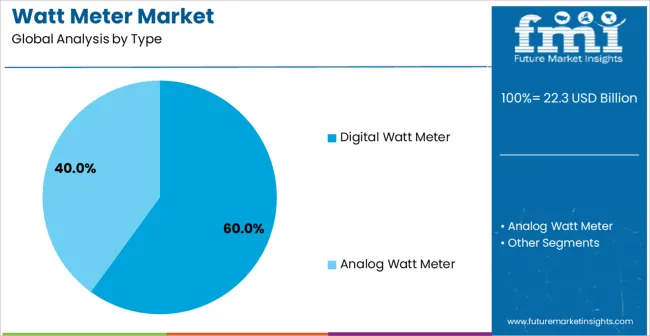
The Digital Watt Meter type is projected to hold 60.00% of the overall market revenue share in 2025, making it the leading type segment. This dominance is being driven by the high accuracy, real-time data monitoring, and multifunctional features that digital devices provide compared to their analog counterparts. The shift toward smart infrastructure has reinforced the adoption of digital watt meters due to their ability to integrate with advanced communication networks and energy management systems.
The strong demand from industries, utilities, and commercial establishments for devices capable of remote monitoring and advanced analytics has further enhanced the adoption of digital watt meters. Their ability to store and transmit data, combined with user-friendly interfaces and automated calibration, has positioned them as the preferred choice in modern power monitoring.
Additionally, rising investments in smart grid projects and renewable power plants have accelerated demand for digital devices that ensure reliability, compliance, and long-term operational efficiency These factors collectively explain why the digital watt meter segment leads the overall market.
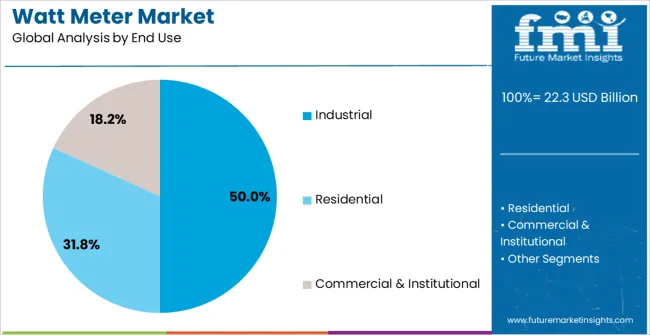
The Industrial end-use segment is expected to capture 50.00% of the total Watt Meter market revenue in 2025, securing the top position among end-use categories. This leading share is being attributed to the widespread application of watt meters in manufacturing, heavy machinery, and process industries, where monitoring of energy consumption and power efficiency is critical. Industries are increasingly relying on watt meters to reduce energy costs, optimize production lines, and ensure compliance with environmental and energy efficiency standards.
The expansion of smart factories and adoption of Industry 4.0 practices have further enhanced the demand for advanced watt meters capable of integrating with automation systems. Rising electricity consumption in industrial hubs has necessitated precise monitoring to avoid downtime and ensure operational stability.
Additionally, investments in predictive maintenance tools and the need for improved load management are supporting the segment’s dominance With global industrial expansion and rising focus on sustainability, watt meters are expected to remain a crucial component of energy management systems across the industrial sector.
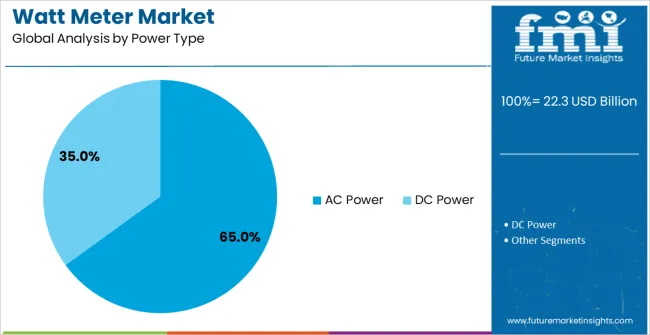
The AC Power segment is forecasted to account for 65.00% of the Watt Meter market revenue in 2025, making it the largest contributor among power type categories. This dominance is being reinforced by the extensive use of alternating current across industrial, commercial, and residential applications worldwide. Watt meters designed for AC power monitoring have gained traction because of their ability to accurately measure fluctuating loads and complex consumption patterns in real-world operating conditions.
The rapid growth of industrial automation, urban infrastructure, and residential electrification projects has intensified demand for AC power measurement solutions. Moreover, increasing deployment of AC-based distribution networks and the expansion of renewable energy systems feeding into AC grids have further accelerated the segment’s prominence.
The segment has also benefited from regulatory emphasis on energy efficiency, encouraging adoption of devices that ensure compliance and accurate energy reporting With alternating current remaining the dominant form of power distribution globally, watt meters designed for AC applications are positioned to sustain their leadership in the market.
Watt meter is an instrument used to measure the electric power. The power distribution company utilizes watt meters to measure the amount of power consumed in the residential and commercial sectors. Further in industrial sector watt meter helps to monitor and measure the power consumption in the industry to calculate utility bills.
Watt meters can be analog or digital which are used according to type. An analog meter consist of fixed coil, known as current coin and a movable coil known as voltage coil. Analog watt meter, are not very accurate and usually have a low measuring range.
In the current market scenario digital watt meters are preferred by the end-users owing to high accuracy, and ease of reading. Watt meter provide true measure of electric power consumer in a DC or AC circuit. Further, with the increasing demand for accuracy and smart measuring methods manufacturers are focusing on innovations.
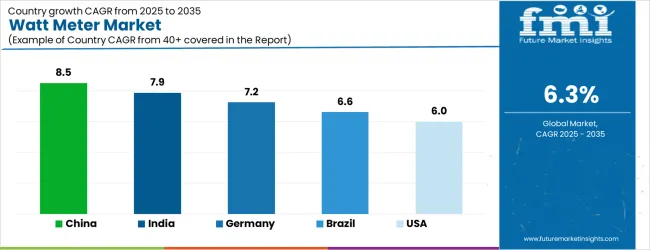
| Country | CAGR |
|---|---|
| China | 8.5% |
| India | 7.9% |
| Germany | 7.2% |
| Brazil | 6.6% |
| USA | 6.0% |
| UK | 5.4% |
| Japan | 4.7% |
The Watt Meter Market is expected to register a CAGR of 6.3% during the forecast period, exhibiting varied country level momentum. China leads with the highest CAGR of 8.5%, followed by India at 7.9%. Developed markets such as Germany, France, and the UK continue to expand steadily, while the USA is likely to grow at consistent rates. Japan posts the lowest CAGR at 4.7%, yet still underscores a broadly positive trajectory for the global Watt Meter Market. In 2024, Germany held a dominant revenue in the Western Europe market and is expected to grow with a CAGR of 7.2%. The USA Watt Meter Market is estimated to be valued at USD 8.1 billion in 2025 and is anticipated to reach a valuation of USD 8.1 billion by 2035. Sales are projected to rise at a CAGR of 0.0% over the forecast period between 2025 and 2035. While Japan and South Korea markets are estimated to be valued at USD 1.1 billion and USD 569.3 million respectively in 2025.
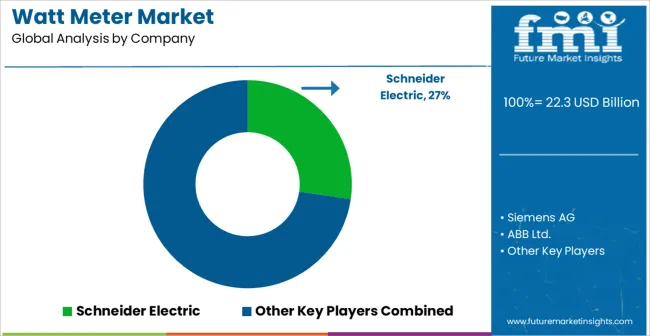
| Item | Value |
|---|---|
| Quantitative Units | USD 22.3 Billion |
| Type | Digital Watt Meter and Analog Watt Meter |
| End Use | Industrial, Residential, and Commercial & Institutional |
| Power Type | AC Power and DC Power |
| Phase | Three Phase and Single Phase |
| Regions Covered | North America, Europe, Asia-Pacific, Latin America, Middle East & Africa |
| Country Covered | United States, Canada, Germany, France, United Kingdom, China, Japan, India, Brazil, South Africa |
| Key Companies Profiled | Schneider Electric, Siemens AG, ABB Ltd., Honeywell International Inc., General Electric, Landis+Gyr, Itron Inc., and Elster Group |
The global watt meter market is estimated to be valued at USD 22.3 billion in 2025.
The market size for the watt meter market is projected to reach USD 41.1 billion by 2035.
The watt meter market is expected to grow at a 6.3% CAGR between 2025 and 2035.
The key product types in watt meter market are digital watt meter and analog watt meter.
In terms of end use, industrial segment to command 50.0% share in the watt meter market in 2025.






Our Research Products

The "Full Research Suite" delivers actionable market intel, deep dives on markets or technologies, so clients act faster, cut risk, and unlock growth.

The Leaderboard benchmarks and ranks top vendors, classifying them as Established Leaders, Leading Challengers, or Disruptors & Challengers.

Locates where complements amplify value and substitutes erode it, forecasting net impact by horizon

We deliver granular, decision-grade intel: market sizing, 5-year forecasts, pricing, adoption, usage, revenue, and operational KPIs—plus competitor tracking, regulation, and value chains—across 60 countries broadly.

Spot the shifts before they hit your P&L. We track inflection points, adoption curves, pricing moves, and ecosystem plays to show where demand is heading, why it is changing, and what to do next across high-growth markets and disruptive tech

Real-time reads of user behavior. We track shifting priorities, perceptions of today’s and next-gen services, and provider experience, then pace how fast tech moves from trial to adoption, blending buyer, consumer, and channel inputs with social signals (#WhySwitch, #UX).

Partner with our analyst team to build a custom report designed around your business priorities. From analysing market trends to assessing competitors or crafting bespoke datasets, we tailor insights to your needs.
Supplier Intelligence
Discovery & Profiling
Capacity & Footprint
Performance & Risk
Compliance & Governance
Commercial Readiness
Who Supplies Whom
Scorecards & Shortlists
Playbooks & Docs
Category Intelligence
Definition & Scope
Demand & Use Cases
Cost Drivers
Market Structure
Supply Chain Map
Trade & Policy
Operating Norms
Deliverables
Buyer Intelligence
Account Basics
Spend & Scope
Procurement Model
Vendor Requirements
Terms & Policies
Entry Strategy
Pain Points & Triggers
Outputs
Pricing Analysis
Benchmarks
Trends
Should-Cost
Indexation
Landed Cost
Commercial Terms
Deliverables
Brand Analysis
Positioning & Value Prop
Share & Presence
Customer Evidence
Go-to-Market
Digital & Reputation
Compliance & Trust
KPIs & Gaps
Outputs
Full Research Suite comprises of:
Market outlook & trends analysis
Interviews & case studies
Strategic recommendations
Vendor profiles & capabilities analysis
5-year forecasts
8 regions and 60+ country-level data splits
Market segment data splits
12 months of continuous data updates
DELIVERED AS:
PDF EXCEL ONLINE
Metering Pump Market Size and Share Forecast Outlook 2025 to 2035
Metered Dose Squeeze Dispenser Market Size and Share Forecast Outlook 2025 to 2035
The Metered Dose Inhalers Market is Segmented by Type, and End User from 2025 to 2035
Cemetery Software Market Size and Share Forecast Outlook 2025 to 2035
Ammeters Market Size and Share Forecast Outlook 2025 to 2035
Diameter Signaling Market Size and Share Forecast Outlook 2025 to 2035
Odometer Market Trends – Growth & Forecast 2025 to 2035
pH Meter Market Growth – Trends & Forecast 2019-2027
Bolometer Market Size and Share Forecast Outlook 2025 to 2035
Barometer Market Size and Share Forecast Outlook 2025 to 2035
Ohm Meter Market Size and Share Forecast Outlook 2025 to 2035
Durometer Market Size and Share Forecast Outlook 2025 to 2035
Ergometers Market Size and Share Forecast Outlook 2025 to 2035
Rheometers Market Size and Share Forecast Outlook 2025 to 2035
LCR Meters Market Analysis - Size, Share, and Forecast Outlook 2025 to 2035
Gas Meters Market Growth - Trends & Forecast 2025 to 2035
AI-Secured Perimeters – Advanced Intrusion Detection Solutions
Manometers Market
Pyrometer Market
TDS Meter Market Growth – Trends & Forecast 2019-2027

Thank you!
You will receive an email from our Business Development Manager. Please be sure to check your SPAM/JUNK folder too.
Chat With
MaRIA